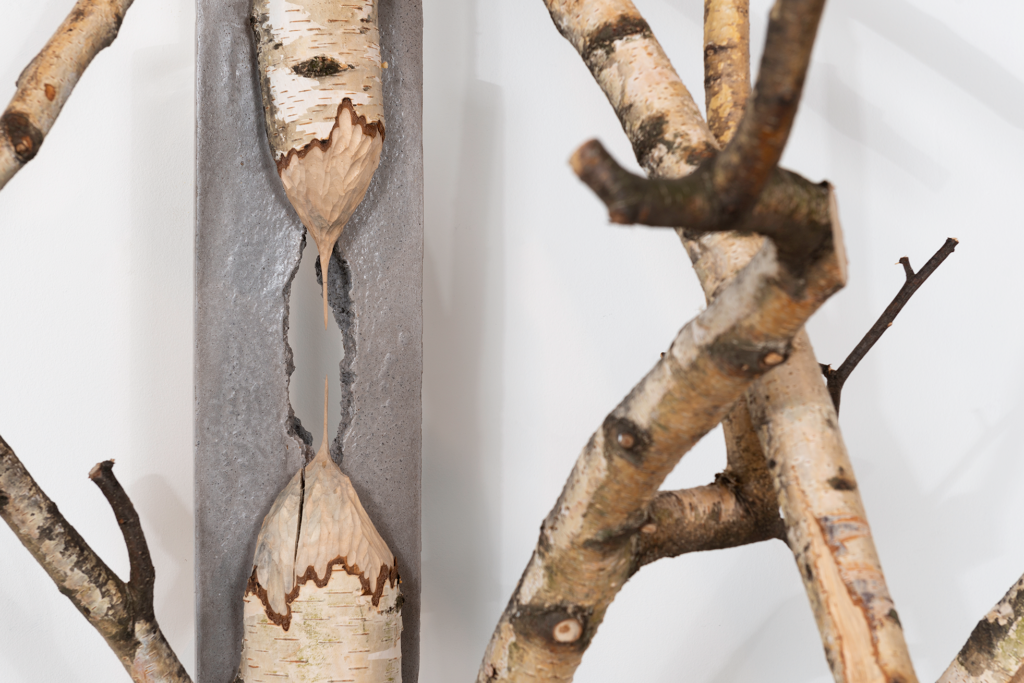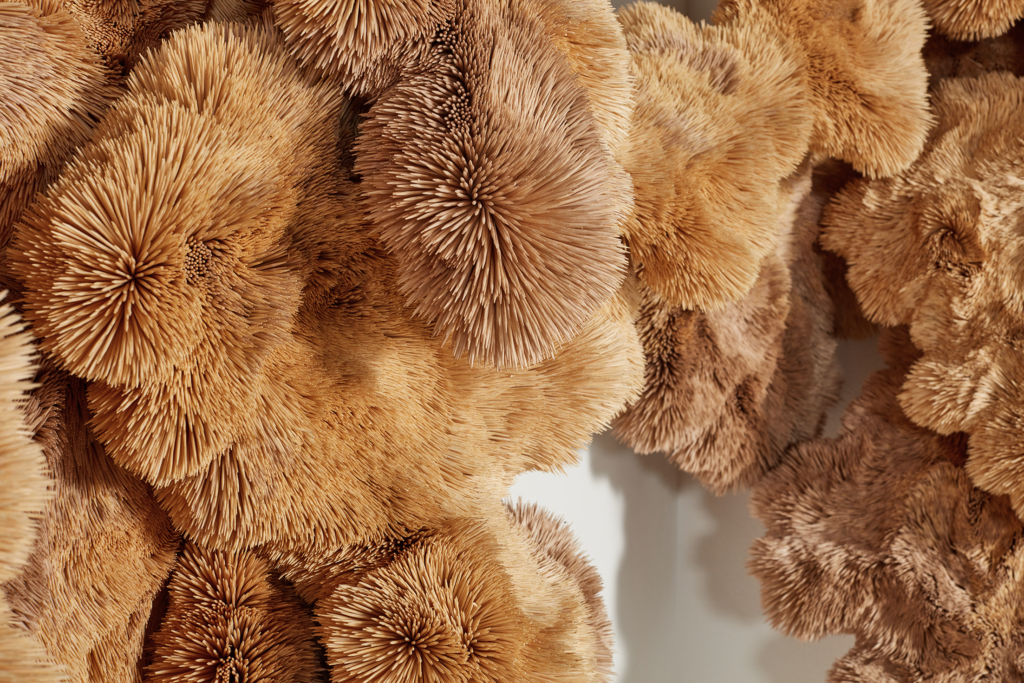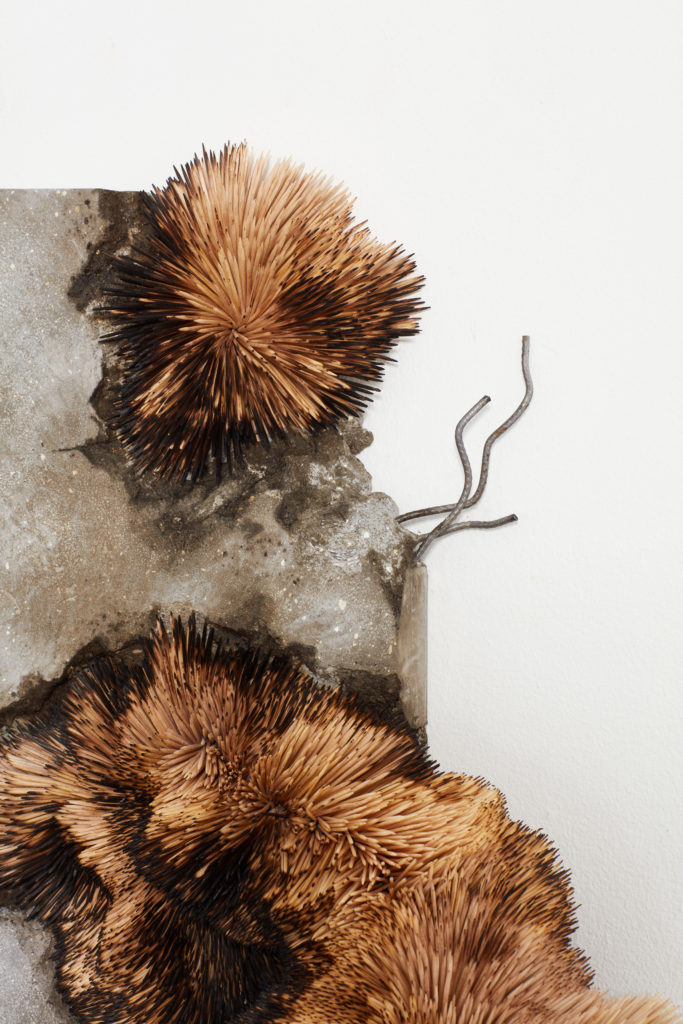

By Cur8.art
Most widely known for his experimental sculptural works made from toothpicks and bottle caps, Chris Soal’s practice as a contemporary, emerging artist is on an expanding trajectory. At 28, Soal’s abstracted works already show the artist’s enthusiasm and daring attitude towards pushing materials through the large and engrossing scale of his work. Visiting Soal’s studio in Paarden Eiland, we discussed the award-winning artist’s day-to-day life, uncovering what it takes to build a sustainable career as a professional artist.
What is the inspiration behind your work?
The theme of erosion links to what I’ve been working on over the last two years. Erosion and the breakage and the ruin are all things that we try to patina over, or mend, or fix. They’re the disregarded things we try to restore in some manner. They are never allowed to exist in the state that they are. The idea of a ruin or an erosion is what has been removed, the exterior of something has fallen apart and so we are seeing an interior, so there’s this new perspective of the object or material. But I know that work leads to more work, and my work takes me on a journey to understanding. I’m interested in personal things but as I’m working certain things become more a part of it, certain themes stand out and as I pursue those in greater detail I get led down certain rabbit holes. Because my work challenges perception so much in terms of what we perceive to be from a distance as well as our movement in space in relation to what the sculpture is, perception has become something I’m thinking more of thematically as well.




Take us back to your beginnings as an artist. Has it always been sculpture and when did you first begin experimenting with discarded materials?
I guess the story changes every time I tell it. Until I was 19, I wasn’t very interested in being an artist, well at least I hadn’t admitted to myself that I was. I had taken art as a matric subject so I was interested in it but I told myself I took it to balance out the science and the math. My matric drawings all sold and that was a lightbulb moment. After school I took a year off travelling, working in England teaching kids at a school, and it was there that I had a break to think about what I wanted for my life. The art teacher at the primary school I worked with did a great job at introducing me to contemporary visual artists like the YBA’s, to the Turner Prize and the Tate Museum. I was visiting the Tate some weekends when I was in London. When you discover that someone like Damien Hirst exists and is the richest artist in the world, richer than some bankers you can move past Van Gogh cutting his ear off and starving to death, and you realize it can be a viable reality for you as a human being to exist. I also met two or three artists that year who were not starving and seemed pretty happy. It was a nice realisation.
And my parents were like if you’re thirty years old and working out of our garage we will support you, we’ve got you, we just want you to do what you need to do. And that was huge.
Your work really pushes and explores the boundaries of perception, tactility and the senses – what do you want people to gain from this mind bending experience of your work?
My work tries to exist in a space that is not a linear or dialect form of knowledge. If I could say what I’m trying to do I would try to write it. But I think there’s a type of knowledge or understanding that can only be absorbed through the body or being in the presence of something because the work creates these visceral reactions from you. They create these illusions when you know what you’re seeing can’t be reality. Like either the grimace in proximity to the toothpicks – realizing they are sharp and not soft and inviting, or the grotesqueness of these writhing bottle top forms that some see as serpents or intestines, or the optical delight in seeing something shift before your very eyes as you move around it. I think those kinds of bodily sensations create a type of knowing or knowledge that hopefully embeds itself deeply. My work is just about encouraging people to explore new ways of thinking and being in the world. I’ve made these works abstract so that there are multiple points of entry into them, but the fact that the materials are so commonplace and recognisable gives everyone a point of entry so it’s not doesn’t exist beyond our grasp. The fact that people just encounter them is probably enough for me, but what people get out of it Is completely dependent on their context. For example, the coral reference can only be seen by people who have encountered coral, but for people who have maybe been hunting or cleaned animal skin, they see the framed works as animal skins themselves. So it all depends on how people come to the work with different histories and contexts.
What does your day-to-day as a professional artist look like?
I don’t have a solid schedule or a solid routine but the studio has a pretty regular routine. Everyone clocks in at 8:30 and leaves at 5, although under circumstances like these we work a little later. The fact that the studio can almost run autonomously without me is a major benefit that we have spent a lot of time setting up. With travel, residencies, and other stuff I don’t want to be the reason work doesn’t go ahead. I don’t want to stop and start other people’s careers and lives. So the idea of consistency even in my absence is something we are trying to work on. I will try to get into the studio by 10 and leave between 6 and 7 at night. In the mornings, I spend time journaling, reading just getting myself into a good headspace for the day. That is either morning pages of stream-of-consciousness writing or more thoughtful journaling and reading. I usually try to fit in a workout in the morning so that I’m fresh. At the studio there is admin, and email – sometimes there are days when I don’t touch my laptop at all.


So we will usually do a bit of housekeeping – is there anything that needs to be paid, any bills etc. Jonathan will check in with me about the plan of action for the day. I will usually try to spend some time working ahead so if I’m anticipating that we’re going to finish these three things I will try and work ahead on the next group of tasks. I find it incredibly beneficial that I’m working on many different things at the same time because going back to the notion of time it’s a paradox because things here need to continue but certain things take longer so what I try and do is to work on the things that I feel momentum on and let other things gestate. There will be things like checking in on progress, usually, a bit of design, work putting ideas into 2D before we make 3D decisions and then usually I will try to spend a few hours of the day hands-on working on stuff. Whether that’s things that I personally need to do in the studio like burning or chipping, casting or sanding – anything I haven’t outsourced. Maybe on a nice day, I’ll try to break up my work into 90 minutes segments. My time primarily is divided between writing and research, hands-on production, future planning and production, administrative duties and delegation and external business interactions with galleries, collectors and press. There is a whole production process but the artistic process is materially led. It’s about observing a material or having an encounter with materials in the real world that leaves an impression on me and after processing that impression it manifests through the work. Things are very organic with how they manifest in the studio. In one sense it’s quite a collaborative process with the material pushing its limits and finding new areas of interest and possibility.
How long does it take to complete one of your works?
I would estimate a month but it completely depends on the material, for example, the bottle tops take forever to process and then we make a piece out of them which also takes a while depending on the work so the bottle top works can take anywhere from six months to a year or 3 months. The toothpick works can move a little bit quicker because we’ve got a nice process going on but it depends on their construction, but I would say a month.


Are there any new materials you are experimenting with?
The new technique I’m working on is a form of printmaking. I’ve used sandpaper and I have eroded the sand on the paper to reveal the paper below. The process involves printmaking and erosion, and it has this depiction of cracked earth. There are some used sandpaper discs we’ve collected from carpentry workshops in the area and we are playing with different configurations. There’s a big one in the studio we did; it’s more like an eroded creation. I tried pushing the material to the place where it surprises me and moves in a direction that I haven’t seen before. I don’t put the question of originality too much on me because I think that will suffocate you before you even get anywhere, but once you’ve done something with the material you have to ask if it’s worth it because of that amount of work. I’ve never been particularly interested in sculptors that take their sculptures and make drawings of them or create drawings referencing their sculptures – it doesn’t extend into my practice in any meaningful way. I think that’s more of an economic model to make your work more accessible or to extend your audience. I’ve wanted something that aligns more with the intention of my work, something materially oriented that pushes beyond its capacity or intention.
You’ve won a number of awards and have participated in several residencies, what has been the standout moment on your journey thus far?
The Dior collab was crazy and unexpected. It came out of nowhere after I showed some work in London. The work was seen by people in the Dior team and the next thing I knew I was contacted to be part of season five of the Lady Dior art project. I was the youngest artist they had collaborated with. It was amazing and it helped grow my career, and my network and gave me a bit of validation at an early age. The other one was an auction for charity, the South African Foundation of contemporary art called the SEED auction which they hosted in Johannesburg. I was invited to be part of it and every invited artist had to nominate an artist. It turned out later that William Kentridge was part of that auction and had nominated me.
Who are some artists on your radar at the moment?
International: Alicja Kwade, Julian Charrière and Michael Rakowitz
Local: Igshaan Adams, Bronwyn katz and Abongile Sidzumo
What advice would you give to artists trying to break into the industry?
Go to every exhibition opening you can for the next three months and just hang out, don’t tell people you’re an artist, don’t shove your work in their face, just be there, look, greet, and drink the wine. Then make one hundred drawings in the next three months and bring it back – let’s look – and in that hundred there are going to be ten that are decent and at least two that are amazing and then we know where to start and that’s how it happens.


Do you listen to anything while you are working – music, podcasts?
I often have music in the space but some days I just need silence. Some days it’s loud music, some days absolute silence and other days I’m wearing my headphones for even another level of silence.
What’s next?
I’ve done a few shows now I’ve had the highs and the lows of having shows they’ve all gone super well but internally having been satisfied with them or not being satisfied with them coming down off the high of having a show into making a new body of work and the pressure of finding new things I don’t know what’s next I think at this stage I’m actually just really happy to commit myself to the process and give things time I’m not so rushed about the work going Places and I’m not trying to put pressure on the hustling and bustling I think that will happen as it’s meant to and maybe it’s because at this moment there’s two or three ideas that I’ve had in the back of my mind for 5 or 6 years and they’ve always come back I’ve tried them a little and I had to leave them aside and go do something else and now I’m starting to see breakthroughs in those areas and so I guess one of them trying to create time in my life… So I guess it’s about maintaining focus on what really matters but just the work and I’m just fortunate that I have managed to set up a bit of environment and which I’m protected from the distractions that usually distract you from and it’s so easy because artist so it’s so difficult to measure productivity you can be in a studio make an amazing art whole day and you walk away and you feel like you’ve done nothing productive where as I can answer 10 emails and and I can feel like I’ve been super productive. So it’s tricky by in the space allowing yourself time to make the work listening to the work developing it further I guess I’m just in a space where I’m Percy just really appreciative of what I have an amazing space to make all the materials and assistance I need to make whenever I make and embracing.
In the studio with Soal, his sculptures warp reality and the boundaries of perception, brimming with illusion his works are anthropomorphic and visually kinetic. Sometimes bordering on the grotesque they prompt us to confront our understanding of the world and how we move and interact with all that is around us. With upcoming exhibitions in Milan, Seoul and the 1-54 Contemporary African Art Fair in London, Soal is an artist working at a prolific scale, forever leaving audiences in anticipation of what he might do next.

